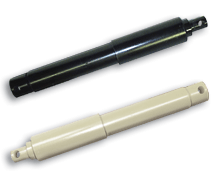Much focus has been placed on moving parts, on gears and power transmission assemblies, yet they’re not wholly responsible for a smooth-moving production line. For every fast-tracking robotic limb or rail-mounted equipment mount, there’s a system dampener, too. Sure, advanced servo motors possess superior motion control circuits, but that’s not enough, not if the line payload is fragile. Working in tandem with the electronics, Enidine Tow Snubbers provide enhanced motion dampening features.
For Fragile Production Line Payloads
This is a place where automobile windscreens are manipulated by end-arm tools. They’re not even plain suckers, they’re large and soft. Equipped with air-sucking apertures, the rubber pads make the delicate glass panels pirouette daintily while navigating large equipment stations. The system works like clockwork, but it lacks one important feature. Without a number of intelligently mounted Enidine Tow Bar Snubbers, the arm acceleration and deceleration action will likely prove too much. The powerful air suckers will disengage, the glass slip free, and the whole line will come to a messy halt. If the ballet-like mechanical motion is to enjoy a motion-dampening feature, the line desperately needs those force absorbing devices.
A Best Features Guide
When an end-arm tool accelerates or decelerates, inertia dampeners are there to counteract the stored momentum. If the transported item can’t cope with heavy shock forces, the same dampeners are in place to cancel out vibrational noise. A partially assembled product moves rapidly, yet it brakes to a stop as required. As a result of this force dampening effect, productivity figures go up while equipment downtime periods drop. Furthermore, equipment longevity is assured, for there’s no shock energy to cause damage. Even on a planned maintenance chart, the benefits become clear. Equipment wear and tear problems are practically non-existent, and the same can be said for payload damage.
Tow Bar Snubbers: An Internal Study
Stamped with an IND634 identifier label, an Enidine Tow Bar Snubber gets the breakdown treatment. Inside the inertial dampener, a synthetic fluid uses its hydrocarbon-based energy absorption architecture to cancel out strong, product-damaging shock energies. The cylindrical housing and internal components package work unaffected, even when the work environment produces 162˚C of blistering heat. Better yet, to handle, say, the acceleration caused by a fast-travelling automobile section, 44,400-Newtons of optimally sealed tow snubbing power is instantly on-call to cushion the load stress.
Heavy loads produce inertial stresses. Even lighter loads, those made of fragile glass or soft plastics, suffer when automated manufacturing lines press for more speed. Designed to counteract these line stresses and inertial forces, Enidine Tow Bar Snubbers provide pure fluid-based cushioning. Used mainly on automated automobile manufacturing systems, the tough cylindrical housings are also finding homes in other robot-dominated production lines, too.
For more information, download the Tow Bar Snubbers catalogue, visit our Enidine page or contact us.


